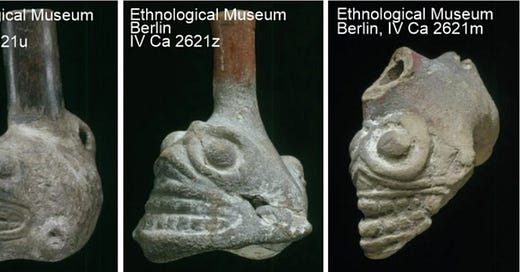One of the best things about being a historian is to read ground-breaking new work by colleagues. For the last decade of so, I’ve been reading widely about Mesoamerican histories and societies - partly to compare them with parallels in parts of the world that I am more familiar with, primarily in Asia.
One reason is because of the parallels; another is because the many differences - such as those resulting from the biological fluke of the death of pack animals in the Americas compared to Asia: horses and camels allowed for very different models of exchange as well as cultural development which I am currently trying to measure empircally.
Silk Roads trading networks across Eurasia also offer some interesting comparisons with those of Mesoamerica in terms of types and volumes of goods, as well as spatial distribution of trading centres, information and communication dissemination and (of course) patterns of rulership and all manner of religious and other ritual.
So I was very intersted to read a fascinating new paper focusing on Psychoacoustic and Archeoacoustic nature of ancient Aztec skull whistles. (I use Aztec here rather than ‘Mexica’ as it is the terminology used by the paper’s authors)
As the authors note:
Since Paleolithic times, humans created sophisticated musical instruments to produce sounds for various purposes ranging from imitating environmental and animal sounds up to aesthetic and symbolic manifestations.
Musical instruments made from skulls are unusual. The ones discussed by the authors are ‘made from clay with an approximate size of 3–5 cm. They have a particular sound production mechanism, which makes the Aztec skull whistles rather unique and unusual sound tools compared to historical and contemporary music instruments.’
One reason I am interested in these is because of the roles played by skulls in steppe nomad cultures - as well as in India, Tibet and Japan.
My favourite stories involving skull cups involved the death of Sviatoslav of Kyiv. According to the Russian Primary Chronicle, Sviatoslav - a pushy and divisive figure - was killed in a confronation with Pechengs nomads in 972, and had his skull lined wiht silver and turned into a ceremonial drinking chalice. It was greatly prized by his opponents, because of Sviatoslav’s high status.
Something similar happened with the head of the Byzantine Emperor Nikephoros I who was killed in battle fighting against Krum, the famous leader of the Bulgars, in 811.
According to Theophanes, Krum ‘cut off the head of Nikephoros and for several days hung it on a pole so as to exhibit it to the tribes that came before him and to dishonour us. After that, he bared the skull, reveted it on the outside with silver and, in his pride, made the chieftains of the Slavs drink from it.’
Here is a 14th century image of the emperor’s skull, filled with wine, being delivered to the khan.
In the Aztec case, skulls had a different role - although exactly what this was is hotly debated. The skulls that were turned into musical instruments are often described as ‘death whistles’ that were used to scare enemies, despite the fact that there is little evidence to show that this was the case.
We know that skull whistles
produce a specific non-linear and noisy sound (wind- or hiss-like sound) that can have a shrill, piercing, and scream-like sound quality when played with intensive air pressure
The authors suggest that the cultural and mythological codex of the Aztecs (dominant in much of what is now Mexico between 1250 and 1521) help explain the use of skulls as cultural and musical objects. In fact, wonder the researchers, it would seem that the skulls are not to battlefield activties but to connections to death and the afterlife.
This skull-like visual iconography might portray Mictlantecuhtli, the Aztec Lord of the Underworld, and might provide a link to Aztec sacrificial cults. The sound iconography reveals a possible association with Ehecatl, the Aztec God of the Wind, who traveled to the underworld to obtain the bones of previous world ages to create humankind.
The fact that skull whistles are usually found in ‘ritual burial sites with human sacrifices’ and link to ritual and ceremonial iconography for the mythological descent into the Mictlan, the Aztec underworld, likewise suggest a ritual use connected with death and in particular the offering of human lives to Aztec gods.
The researchers created original sound recordings from skull whistles, as well as from modern reproductions, conducting experiments into the psychoacoustic effects and affective responses in listeners.
The skull whistles ‘produce a perceptually unique cluster of sounds that share and mimic affective qualities with many other scary and aversive sounds.’
The sound is like a human scream - terrifying and disconcerting.
The aim, then, was to create a sense of dread and fear in onlookers and participants in death and sacrifice events - as if this was not already terrifying enough.
One of the things I enjoyed about the paper was that the authors measured brain activity to guage reactions to the sound on modern day populations. The answer won’t surprise you: those who listened were scared out of their wits too.
For a few reasons, I am interested at the moment in how fear can be used to preserve and embed order in societies - and to enhance the power of elites. This is a terrific paper that I’ve enjoyed for that reason as well. I hope you enjoy reading it as well.






Very interesting--if harrowing--article.